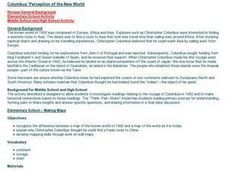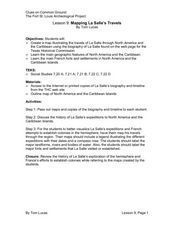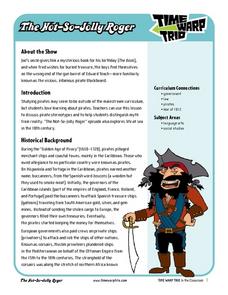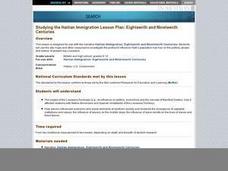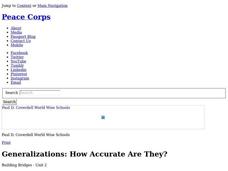Curated OER
How Many Days To America?
Fourth graders determine how many different types of immigrant groups came to America. They discuss how immigrants feel when moving to a new place. They read the story, "How Many Days to America" by Eve Bunting and discuss how some...
Curated OER
Columbus' Perception of the New World
students investigate readings relating to the voyage of Columbus in 1492 and to make historical connections based on those readings. They form pairs to share insights and answer specific questions, and share information in a final class...
Curated OER
Winds of Change
Learners investigate extreme weather patterns. In this current events lesson, students visit selected websites to study hurricanes and their causes. Learners write reports on their findings.
Curated OER
U.S.-Cuba Relations
Students study the history of United State/Cuba relations. In this diplomacy lesson, students research selected websites to gather information regarding various topics of significance between the U.S. and Cuba since 1868. Students...
Curated OER
Fells Point's Role in Shipping and Trade
Eighth graders examine the trade and military advantages of ships built in Fells Point. In this American History lesson, 8th graders analyze primary sources. Students create an encyclopedia of Fells Point.
Curated OER
Horrific Hurricanes
Students study hurricanes and how scientists predict them. In this hurricane lesson students read an article on hurricanes, complete an activity and take a quiz.
Curated OER
Group Headdresses
Students create a headdress design. In this visual arts lesson, students work cooperatively in a group and create a headdress design. Students are encouraged to use the conceptual framework of philanthropy while working as a team to...
Curated OER
Rooster's Night Out
First graders complete interdisciplinary activities associated with a folktale from Cuba. In this Cuban folktale lesson, 1st graders read the Rooster's Night Out, before completing comprehension worksheets, make recipes, and...
Curated OER
Change Happens
Fifth graders engage in a lesson to find information about the natural history of Puerto Rico. They practice using a variety of resources for research purposes. The same process of research is used for state of Wisconsin. Then students...
Curated OER
Mapping La Salle's Travels
Students use the internet to create a map showing the path of La Salle through North America and the Caribbean. They identify the main geographic features of the two areas and the main French forts. They also complete a timeline.
Curated OER
The Cay
Fifth graders read The Cay as a shared literature experience. This lesson plan has many good activities across the curriculum to keep your students actively engaged in the story. They will do math, art, music, science and geography...
Curated OER
History Today
Young scholars use the newspaper to determine how history is being made in your community, region or country.They identify the different components that comprise a newspaper. This lesson contains adaptations from elementary to high school.
Curated OER
The British Empire – Where the Sun Never Set
Students read an article on the British Empire. In this ESL lesson, students explore the British Empire from the 1600's, then work in small groups to complete several activities that reinforce the information learned in the reading.
EngageNY
Modeling an Invasive Species Population
Context makes everything better! Groups use real data to create models and make predictions. Classmates compare an exponential model to a linear model, then consider the real-life implications.
Curated OER
The Not-So-Jolly Roger
Young scholars assemble details about a pirate voyage and choose which details to include on a postcard that pirate might have written home. They discuss the Pirate Code and determine what should be done in certain "Sticky Situations."
Curated OER
Studying the Haitian Immigration: 18th and 19th centuries
Students read a narrative and conduct extensive research to determine how Haiti's population has had an influence on the social, political, and economic culture of present-day Louisiana. As a culminating activity, students write papers...
Curated OER
Culture Is Like an Iceberg
Students examine features of culture to determine which are visible and which are invisible, and how the invisible affect the visible. They look at both their outline drawing of the iceberg and their Features of Culture worksheet and...
Peace Corps
Features of Culture
Young scholars enumerate features of their own culture and evaluate how those features have influenced their lives. They explain that many differences are related to culture-beliefs and ways of living that are handed down from one...
Curated OER
Columbus Day
Use this Columbus day learning exercise with your EL class. They will read or listen to a passage about Christopher Columbus, then match phrases, fill in the blanks, choose the correct words, unscramble words and sentences, put sentences...
Curated OER
What and Where is Puerto Rico?
Learners explore Puerto Rico. They create K-W-L charts of their prior knowledge of Puerto Rico and observe maps of Puerto Rico. They code the map for measurements and land and water forms. They explore websites to gain background on...
Curated OER
Generalizations: How Accurate Are They?
High schoolers recognize and modify generalizations. They challenge generalizations made about people, insist on knowing the evidence that supports these, and be willing to modify their own generalizations when confronted by evidence...
Curated OER
Seeing Both Sides of an Issue
Young scholars practice the skill of seeing an issue from different points of view.
Curated OER
Following Instructions
Designed to assess your class's ability to follow directions, this reading activity has learners split into groups, read a series of instructions, read a passage, and answer two lists of questions. Can they remember to raise their hand...
Curated OER
A Map is Worth a Thousand Words
Students read the story, "The Most Dangerous Game," by Richard Connell. They discuss specific parts of the story with a group and put their lists on the board. They write a summary of the plot and setting of the story.



